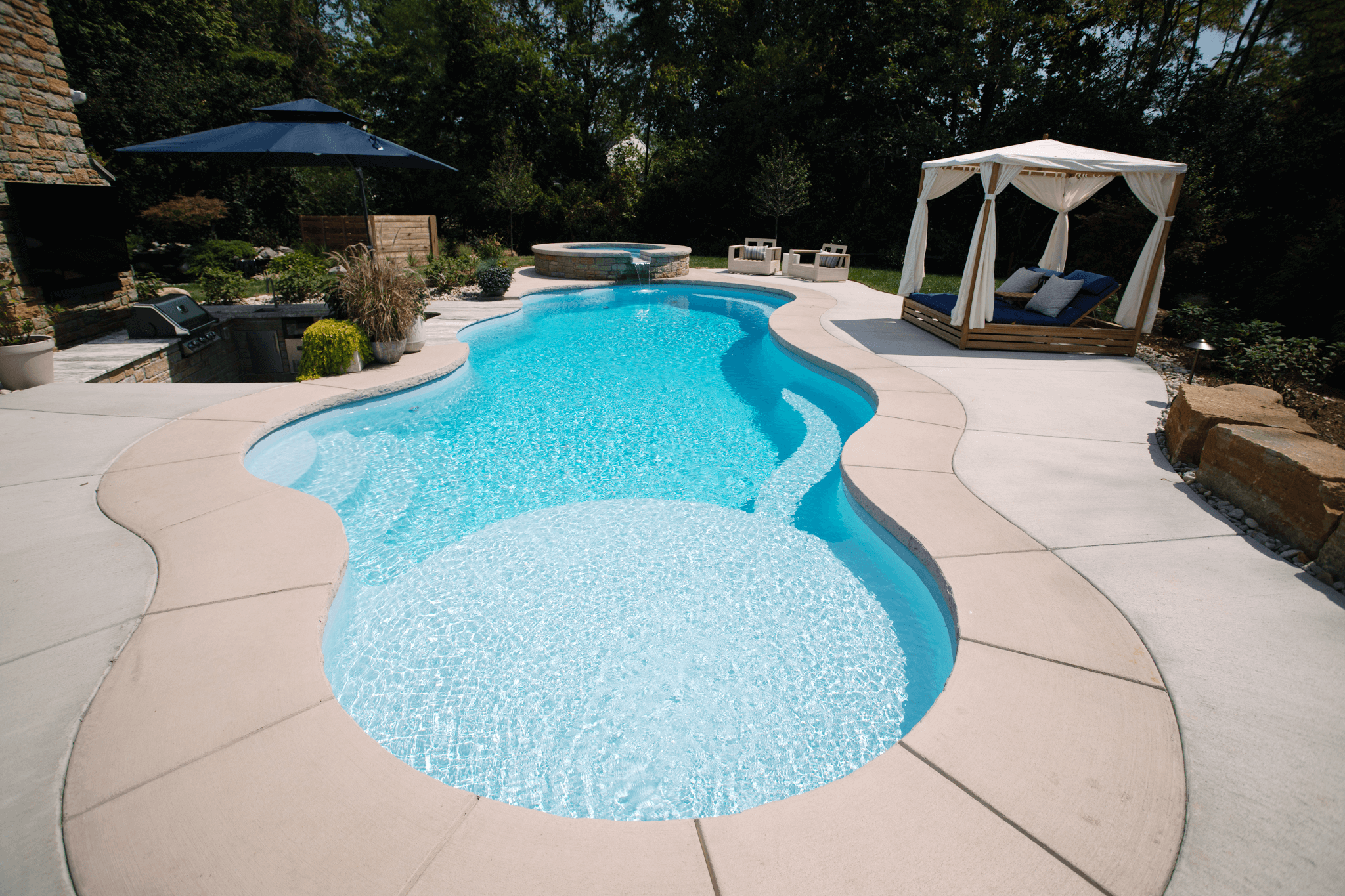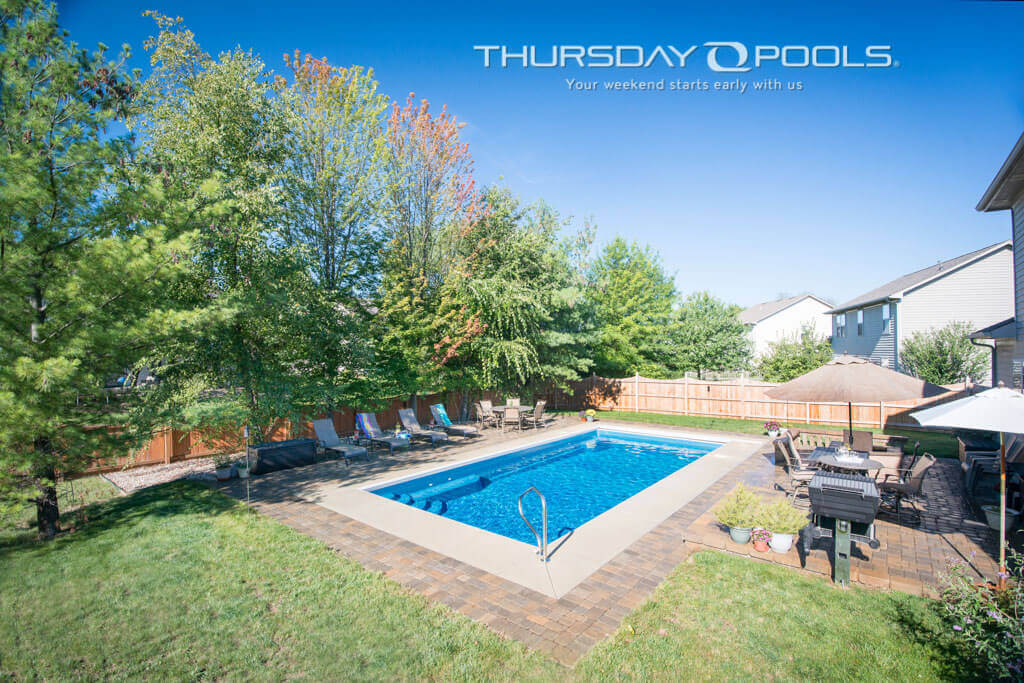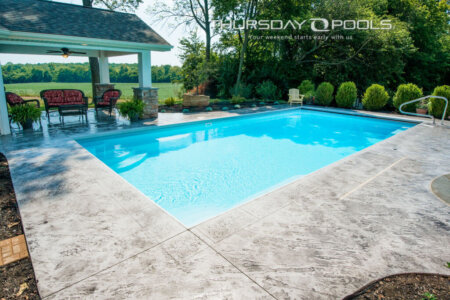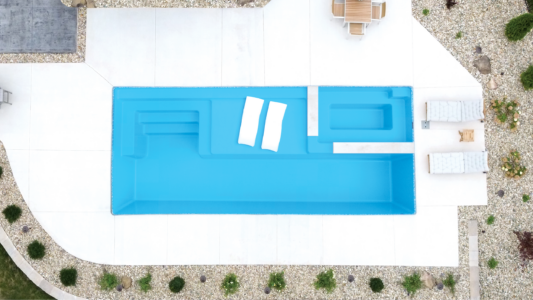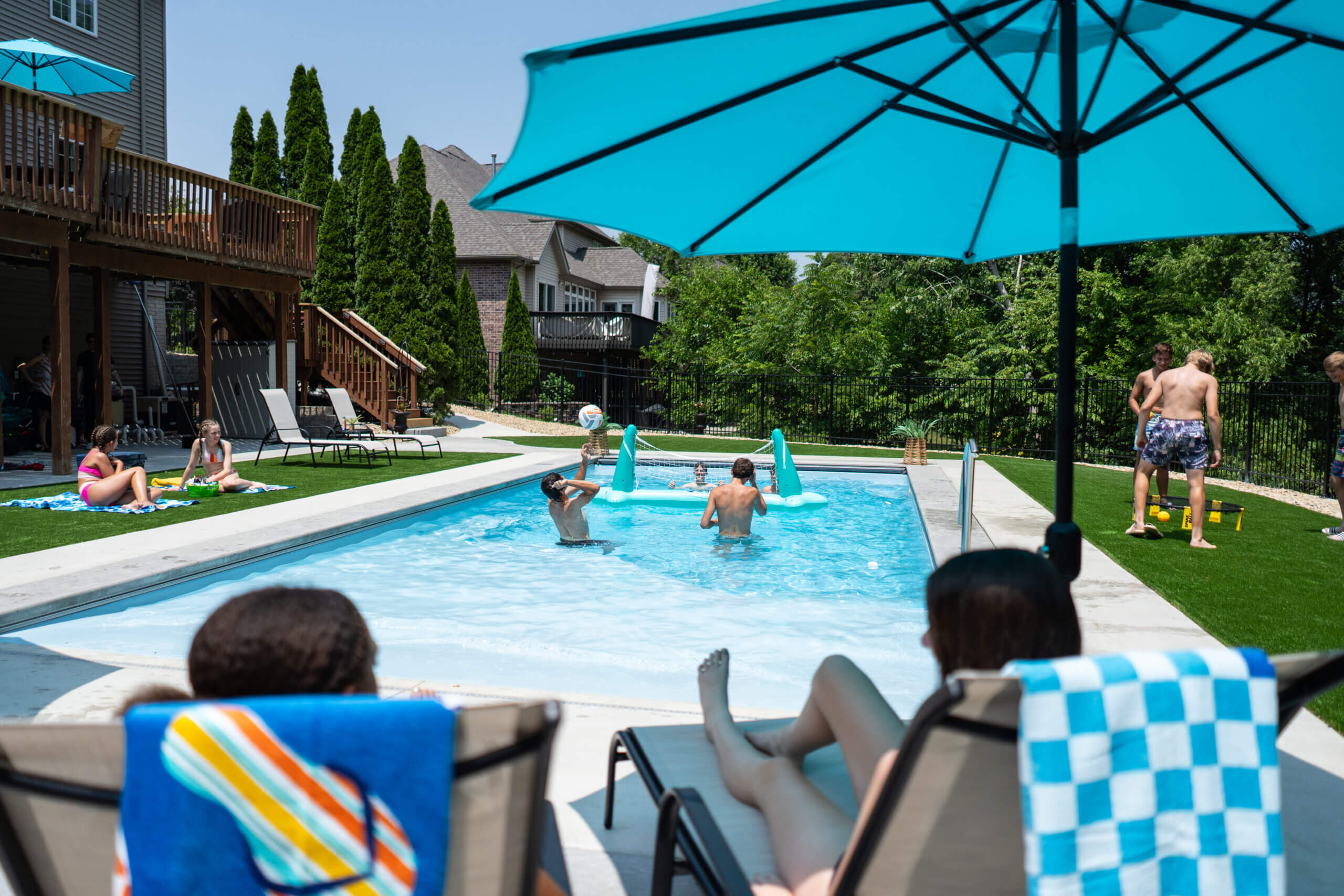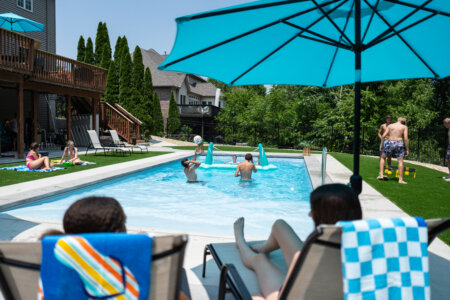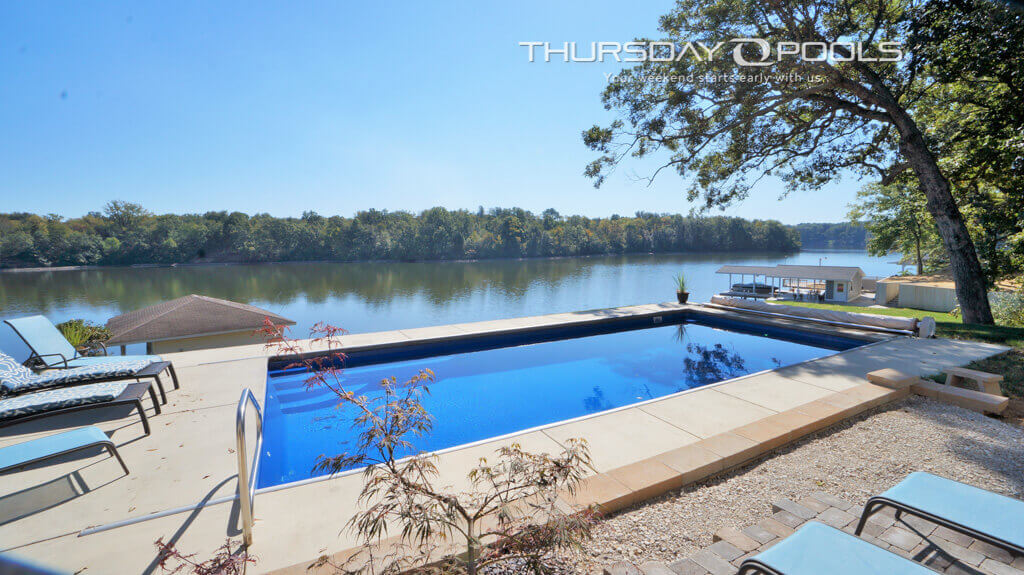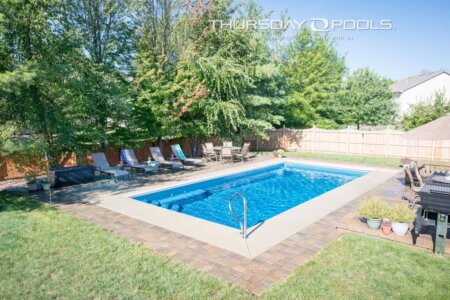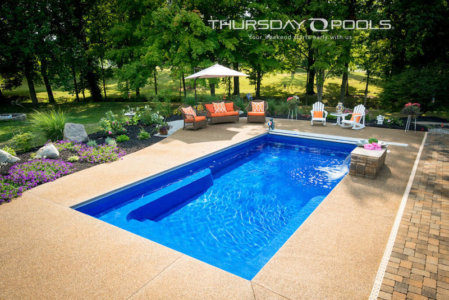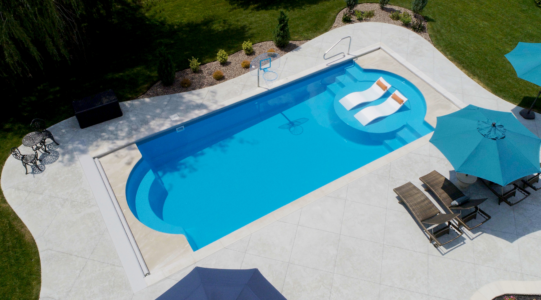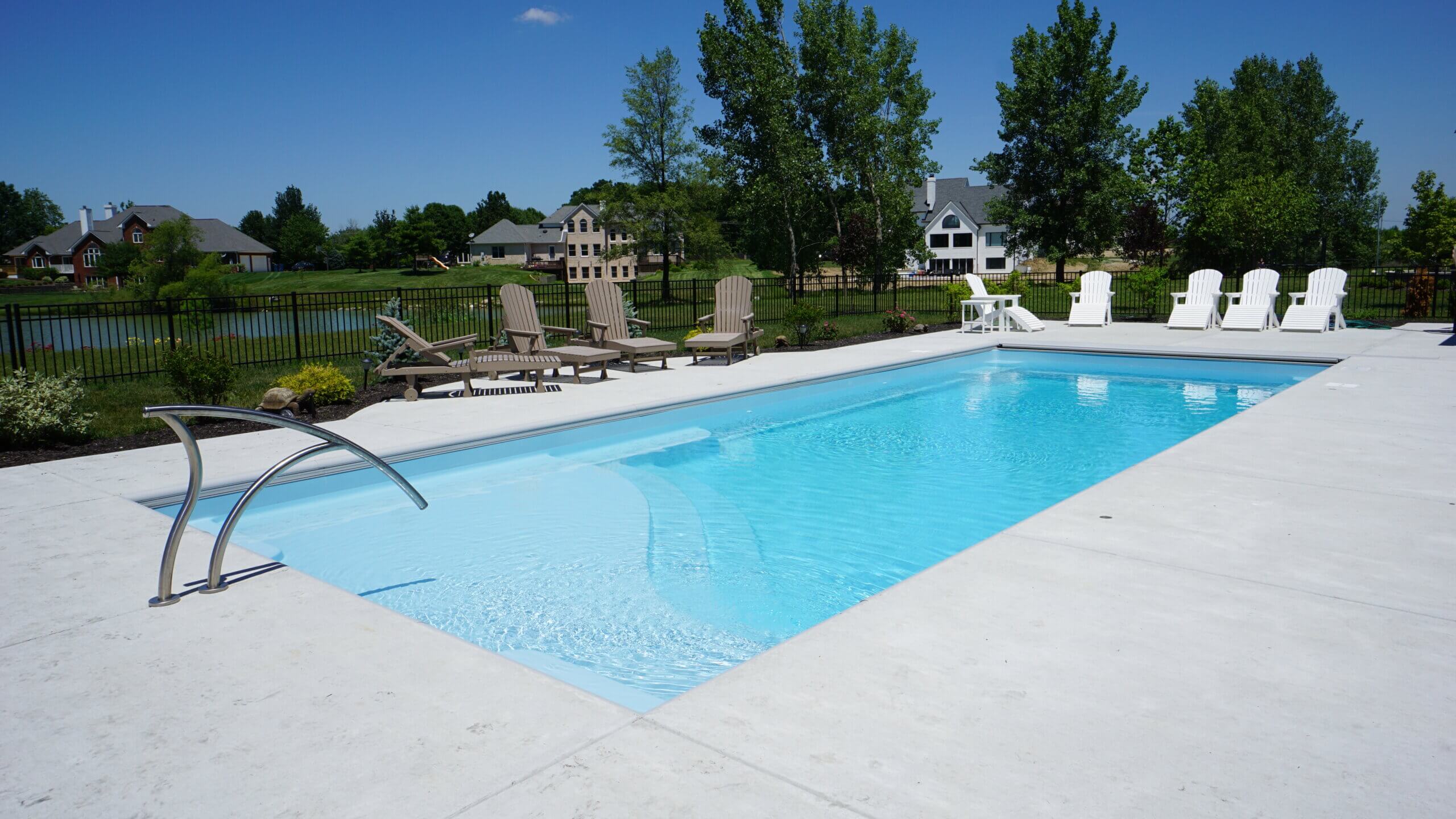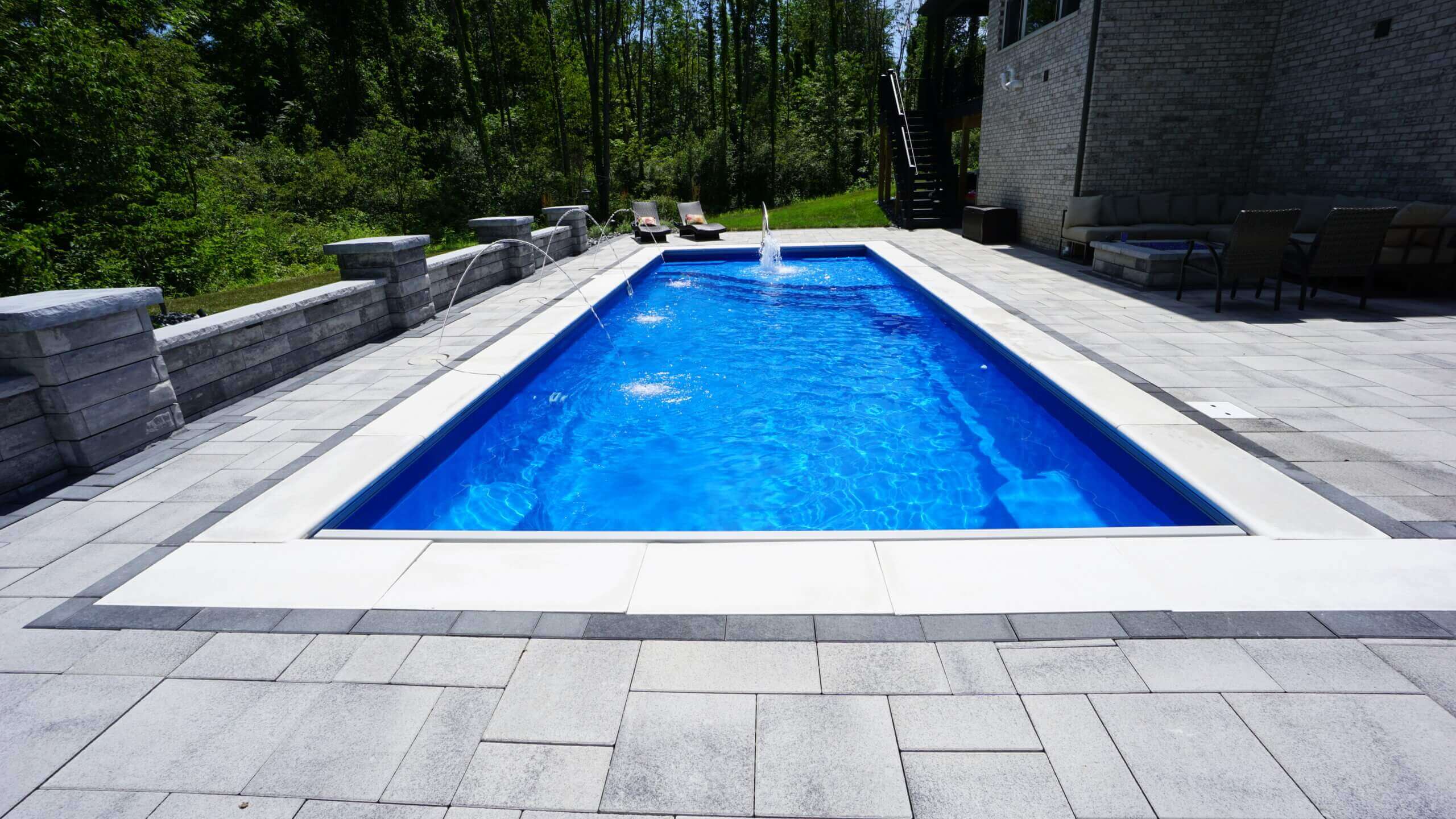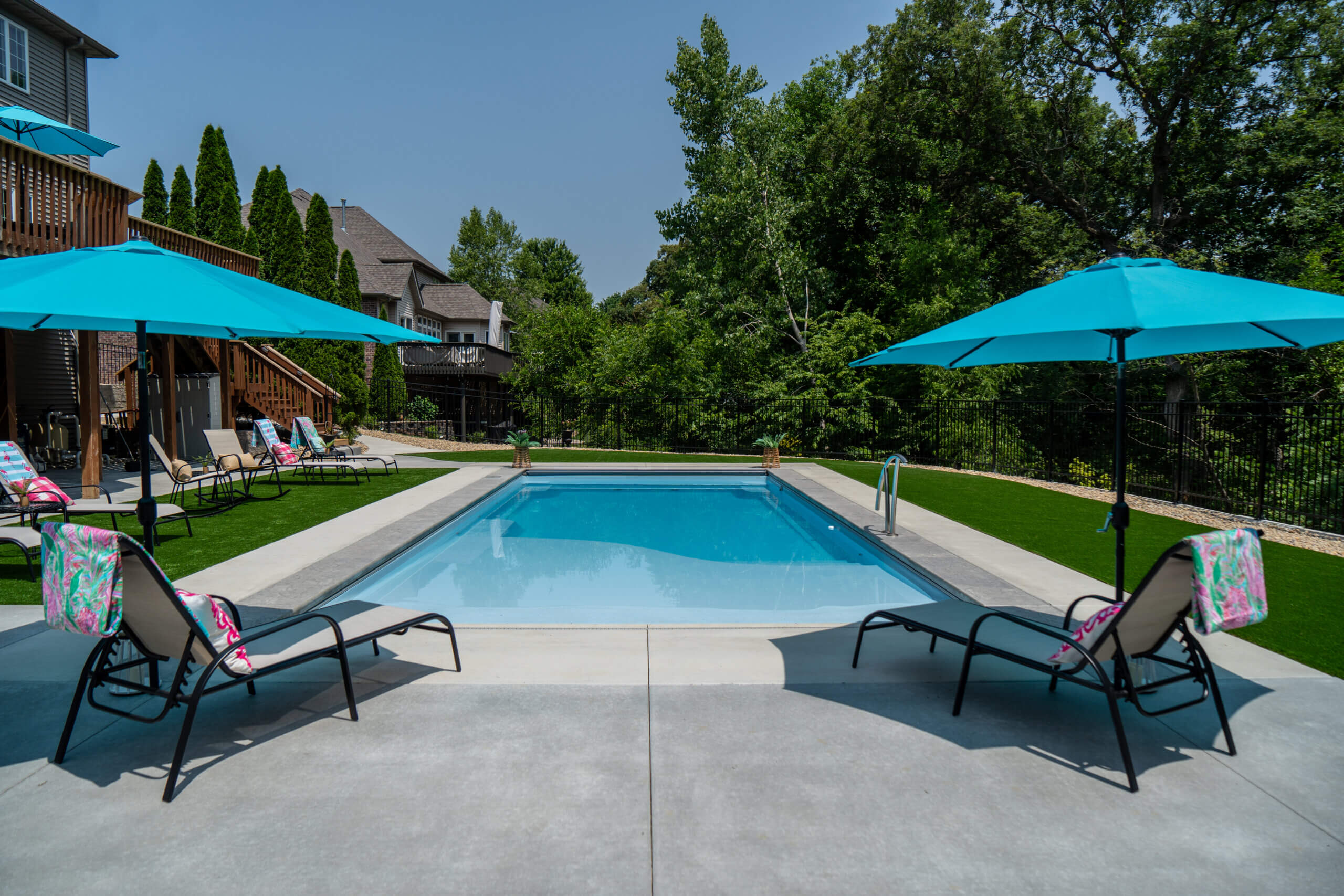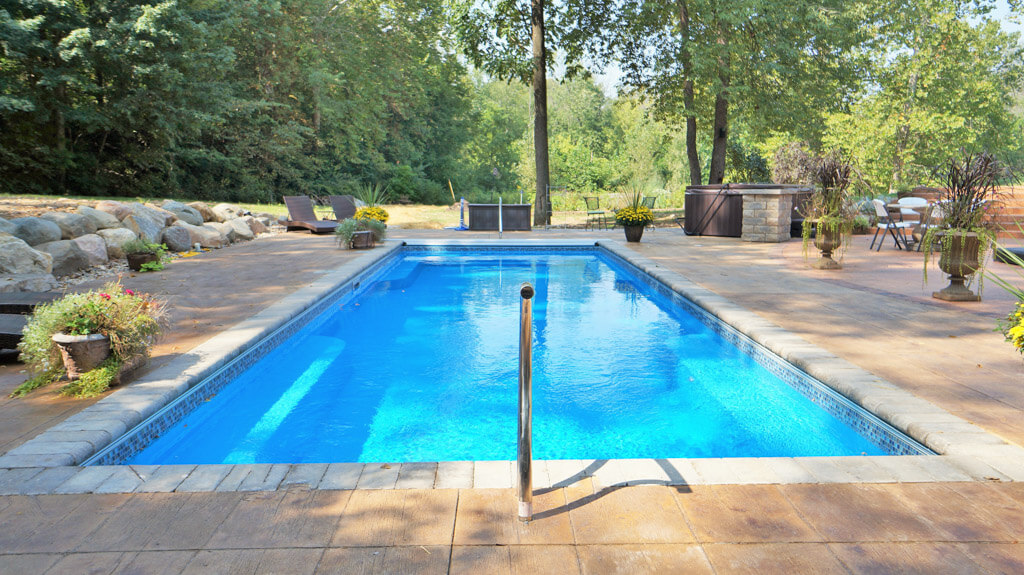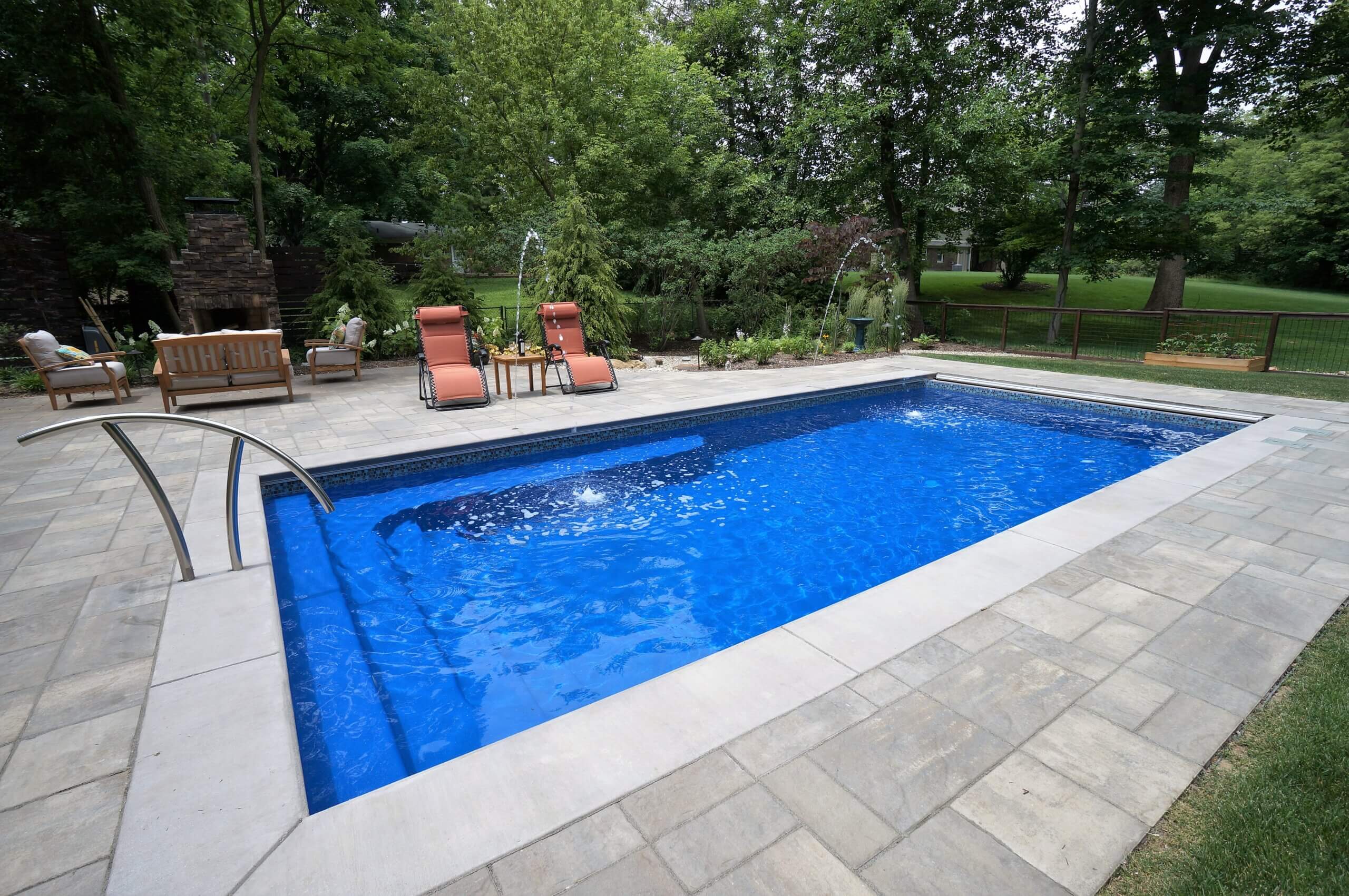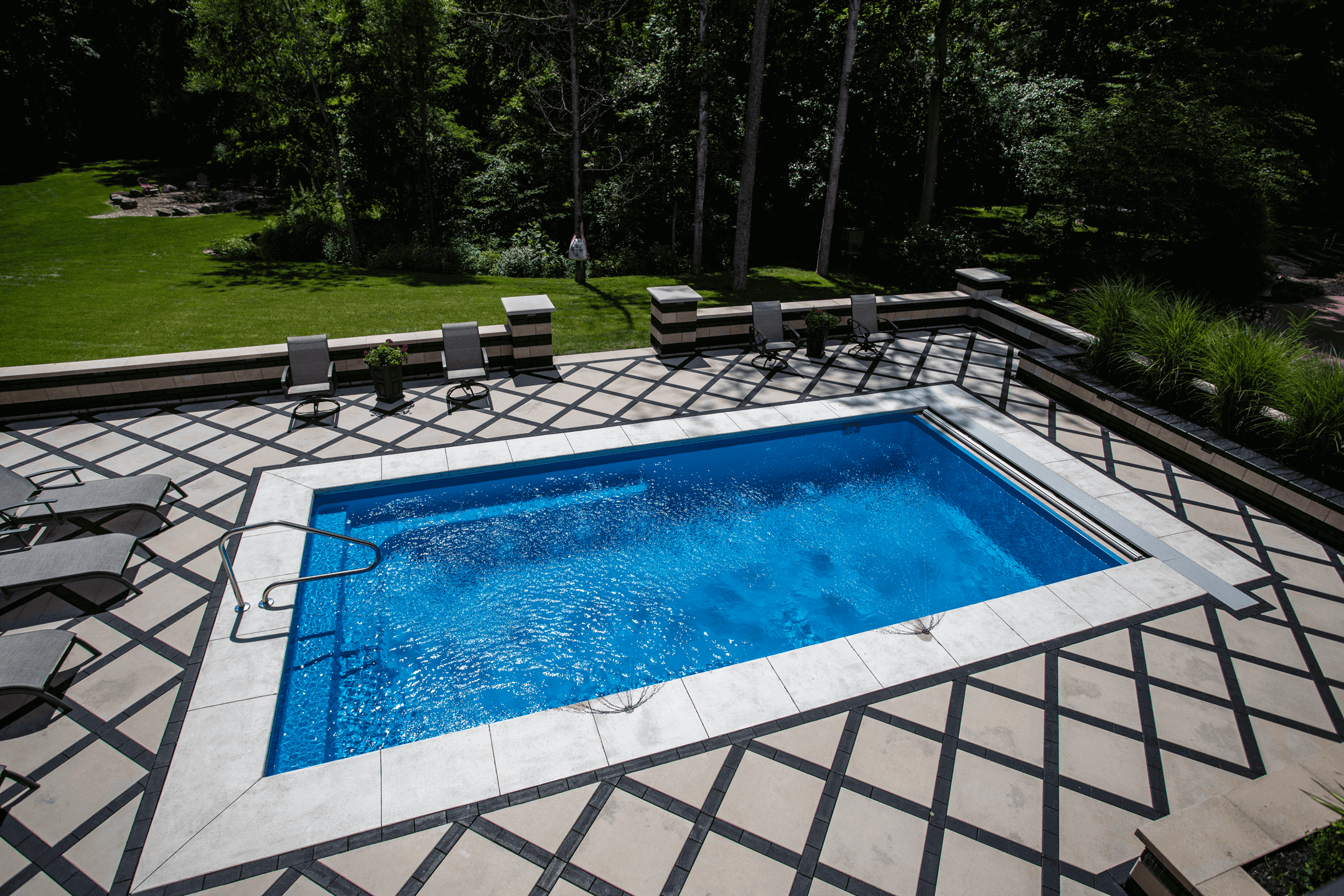When considering fiberglass pool cost in Michigan, it’s important to factor in more than just the pool shell and installation. Michigan’s climate, terrain, and local regulations shape a new pool project’s final price tag. Homeowners across the Detroit metro area, Traverse City, Grand Rapids, and Ann Arbor may face different challenges, from navigating sloped lakefront properties to maximizing smaller urban yards. The state’s long winters and shorter swim seasons also inspire many Michiganders to add features like pool heaters, automatic covers, or attached spas to extend usability in the spring and fall.
Varied soil conditions across the state—from sandy lakeshore lots to heavy-clay conditions inland—also affect excavation costs and site prep needs. Local zoning laws, permitting processes, and seasonal construction windows further influence timelines and budgets. Working with a Michigan-based fiberglass pool expert ensures your design fits your budget, lifestyle, and long-term expectations.
What’s the Average Cost of a Fiberglass Pool Installation in Michigan? Survey Says…
To help Michigan homeowners make smart and informed decisions about their pool investment, Thursday Pools conducted a 2025 survey of our independent dealers throughout the state. The results offer valuable insight into what Michiganders are paying for fiberglass pool installations from the shores of Lake Michigan to neighborhoods around Lansing and the Detroit suburbs.
AVERAGE MICHIGAN FIBERGLASS POOL INSTALLATION BY SIZE |
|||
|---|---|---|---|
| Pool Type | Small Fiberglass Pools | Medium Fiberglass Pools | Large Fiberglass Pools |
| Size Range | Up to 26 ft Long or 400 ft² | 26 to 34 ft Long or 400 to 600 ft² | 35 ft and Longer or 600+ ft² |
| Average Cost | $76,000 | $120,000 | $136,000 |
These numbers can give you a strong starting point, especially if you’re early in the planning process. But every yard differs, shifting costs based on site access, ground conditions, chosen features, and seasonal timing. Want the clearest understanding of what your dream pool might cost? Talk to a trusted local Thursday Pools dealer. They’ll walk you through your options, tailor a quote to your needs, and help you create a pool experience that fits Michigan living.
Average Cost of Popular Pool Models Installed In Michigan
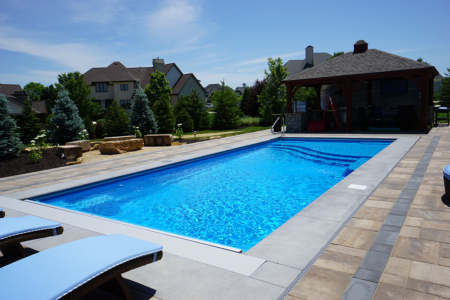
ASPEN (12’ x 25’)
The Aspen‘s smallest footprint makes a strong case for space-savvy design, from compact lakeside retreats in Petoskey to backyard gems in suburban Grand Rapids. Its integrated tanning ledge offers the perfect perch for enjoying Michigan’s summer sun, while the open swim lane and easy-access steps cater to both relaxation and movement. Whether you’re looking to cool off after a workout or host friends for a casual evening dip, the Aspen delivers big functionality without requiring a sprawling yard.
Based on our 2025 survey of Thursday Pools independent dealers in Michigan, the average cost for a standard installation of the Aspen—or another small fiberglass pool design under 26 feet long and 400 square feet—is $76,000.
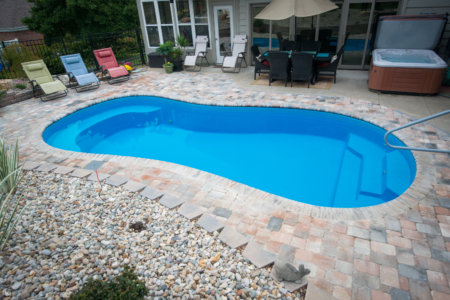
TITUS (14’ x 33’)
The Titus brings a calm and inviting presence to mid-size backyards across Michigan, from tree-lined neighborhoods of Kalamazoo to newer developments in Novi or Midland. Its flowing shape softens traditional yard layouts while offering plenty of built-in comfort zones, including wide entry steps, perimeter seating, and a full-length conversation bench. Ideal for swimming laps, floating under a summer sunset, or catching up with family over the weekend, the Titus carefully balances elegance and function.
According to our 2025 survey, the average cost for standard installation of the Titus or other mid-sized fiberglass pool designs between 26 and 34 feet long or 400 to 600 square feet is $120,000.
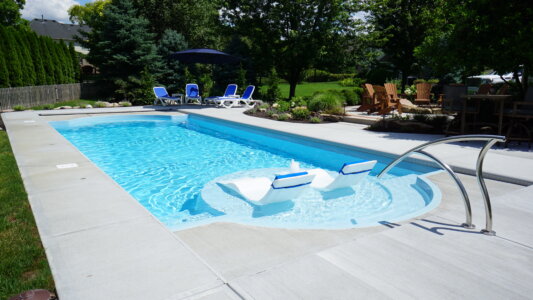
CATHEDRAL LX (16’ x 40’)
The Cathedral LX is ideal for Michigan’s larger properties, such as scenic acreage outside Traverse City or show-stopping backyard builds in Bloomfield Hills. Its formal design pairs traditional elegance with thoughtful, modern touches, including grand entry steps, a spacious tanning ledge, and an expansive swim lane with consistent depth. This large-format pool offers the flexibility to entertain, exercise, or simply unwind in style. Its shape adapts well to Michigan’s diverse landscapes, whether complementing natural woodlands or installing a full outdoor living space with pergolas, fire features, or a spa-ready setup.
Our dealer survey from 2025 shows that the average cost for a standard installation of the Cathedral LX—or other large fiberglass pool models over 35 feet long or more than 600 square feet—is $136,000.
Michigan Landscapes: What Lies Below the Surface Impacts Pool Costs
No two Michigan backyards are the same, and what’s under the grass can have just as much impact on your fiberglass pool project as what’s above it. From sandy soils along Lake Michigan to dense clay beds around Lansing and Flint, ground conditions influence everything from excavation methods to long-term pool stability. Clay-rich soil, for example, holds water and may call for enhanced drainage solutions to protect the pool structure. Conversely, looser sandy soil might require reinforced backfilling to keep everything firmly in place over time.
Then there’s the shape of the land itself. Sloping lots, common in areas like Grand Rapids or the hills around Traverse City, often need grading or retaining walls to create a level, secure base for the pool and patio. These structural additions add to the project scope, but help ensure safety, longevity, and smooth performance year after year.
Access also plays a critical role. Tighter lots in urban settings like Ann Arbor or older neighborhoods with mature trees and fencing can make it difficult to maneuver large installation equipment. In these cases, cranes or alternate delivery methods may be necessary, potentially adding to your overall investment.
| AVERAGE ADDITIONAL YARD-RELATED EXPENSES IN MICHIGAN
|
|
| Excavating Sandy Soil | $1,500 |
| Excavating Clay Soil | $5,750 |
| Excavating Rocky Soil | $3,050 |
| Above-Average Slope Requiring Extra Grading | $3,550 |
| Limited Yard Access | $3,533 |
The good news? An experienced Michigan-based Thursday Pools dealer will evaluate all these site-specific details from the start. With their help, you can plan, stay on budget, and build a pool perfectly suited to your land and how you want to live.
Pool Fencing and Safety Requirements in Michigan: What Homeowners Should Know
Most of Michigan’s residential pool safety laws follow the International Swimming Pool and Spa Code (ISPSC) standards. Generally, homeowners and installers must surround any pool deeper than 24 inches with a barrier at least 48 inches tall using self-closing, self-latching gates. Latches should be at least 54 inches off the ground or on the pool-facing side to reduce the risk of unsupervised access.
Beyond this standard framework, local municipalities often introduce their own specific rules and regulations. The differences can significantly impact your installation timeline and costs.
Norton Shores, for example, outlines clear fencing rules and setback requirements while recommending safety covers for additional protection. Eaton County, meanwhile, enforces its own fencing rules and requires a full site plan that includes the layout of the pool barrier, gate location, setbacks, and electrical inspections. The city of Farmington Hills has detailed barrier design regulations that prohibit climbable surfaces and require pool equipment screening. Milan emphasizes the need for both permanent and temporary fencing, even during the construction phase, while Fraser’s local code includes specific setback requirements and barrier placement and rules about screening visible pool equipment from adjacent properties.
Because regulations vary widely between cities and townships, it’s crucial to consult your local codes early in your planning process. A trusted local Thursday Pools dealer familiar with Michigan’s diverse municipal rules can help you prepare the right documentation, navigate permits, and ensure your pool is safe, secure, and compliant.
According to our 2025 survey of independent Thursday Pools dealers in Michigan, the average cost for a 300-linear-foot pool fence is approximately $5,067.
Customize Your Michigan Pool with Popular Add-Ons and Upgrades
Adding personal touches to your fiberglass pool turns a beautiful backyard into a custom experience. Whether you want to extend your swim season in the Great Lakes State, simplify upkeep, or create a resort-inspired retreat, these optional features can enhance the enjoyment of your investment. Based on feedback from our 2025 survey of independent Michigan dealers, here’s what’s trending—and what to budget.
Comfort, Control, and Clean Water
Pool Heater Average Cost in Michigan: $4,720
Keep the water comfortable even when Michigan’s evenings start to cool. A heater stretches your swim season into spring and fall for more pool days each year.
UV Filter System Average Cost in Michigan: $3,460
Get cleaner, clearer water with less chlorine. UV filtration reduces bacteria and algae without harsh chemicals—great for eco-conscious families or sensitive skin.
Pool Automation and Smart Control System Average Cost in Michigan: $5,920
Adjust lighting, filtration cycles, temperature, and more—from the warmth of your home or on the go with your smartphone.
Automatic Pool Cleaning and Vacuuming System Average Cost in Michigan: $2,800
Make pool ownership even easier with hands-free cleaning that keeps your water sparkling and maintenance time minimal.
Safety and Pool Protection
Automatic Pool Cover Average Cost in Michigan: $16,000
This all-in-one upgrade boosts safety, retains heat, reduces debris, and cuts evaporation—all at the press of a button.
Non-Automatic Safety Pool Cover Average Cost in Michigan: $4,200
A manual safety cover offers peace of mind and reliable coverage at a more affordable upfront cost.
Recreation and Relaxation
Add-On Spa Average Cost in Michigan: $11,140
Relax year-round with an integrated spa that spills over into your pool. It’s the perfect place to warm up after a chilly Michigan evening or wind down after a busy day.
Simple Pool Slide Average Cost in Michigan: $2,300*
Bring classic fun to your pool with a basic slide that’s always a hit with kids and kids at heart.
Deluxe Pool Slide Average Cost in Michigan: $6,040*
Add a twist—literally—with a taller, curvier slide that brings big thrills and a resort-style vibe.
Diving Board (Type 1 Diving Pools Only) Average Cost in Michigan: $3,400*
For deeper, certified Type 1 pools only, a diving board adds extra excitement for confident swimmers.
*Thursday Pools strongly advises against pool slides and diving boards due to safety concerns. The inclusion of a diving board or slide with any fiberglass pool must be carefully reviewed by a licensed professional to ensure compliance with all local building codes, safety regulations, and manufacturer guidelines. Not all fiberglass pool models are suitable for diving or slide use. The homeowner and installer are responsible for ensuring proper installation and usage. Always prioritize safety and consult a qualified expert before adding any diving or sliding feature to your pool.
Patios, Landscaping, and the Surrounding Space
Poured-Concrete Patio (Approx. 1,200 sq. ft.) Average Cost in Michigan: $10,300
This classic, durable choice offers year-round stability through freeze-thaw cycles while framing your pool with clean, modern lines.
Paver Patio (Approx. 1,200 sq. ft.) Average Cost in Michigan: $23,500
Choose from brick, concrete, or stone to bring texture and timeless appeal to your outdoor living area.
Surrounding Landscaping Average Cost in Michigan: $16,000
Create a beautiful, cohesive space with native Michigan plants, trees for privacy, or even a hardscape fire pit to extend backyard use into cooler seasons.
Water Accents and Nighttime Ambience
Specialty Waterline Tile Average Cost in Michigan: $6,400
Elevate your pool’s design with decorative tile that highlights its shape and adds polish and personality.
LED Pool Lights Average Cost in Michigan: $1,505 per light
Make evenings magical with energy-efficient lighting in classic white or color-changing hues for mood-setting fun.
Deck Jets Average Cost in Michigan: $1,033 per jet
Add gentle motion and sound with elegant arcs of water rising from the deck into your pool.
Bubblers Average Cost in Michigan: $2,500 per bubbler
A family favorite for shallow entries or tanning ledges, these playful fountains bring a lighthearted, relaxing vibe.
Cascading Waterfalls Average Cost in Michigan: $4,340
Give your backyard retreat the feel of a natural oasis with a waterfall feature that adds beauty, movement, and calming sounds.
Begin Budgeting for Your Michigan Backyard Retreat Today
Ready to turn your Michigan backyard into a space that sparks joy and generates priceless memories? Whether you’re dreaming of peaceful mornings by the pool in Petoskey or hosting summer gatherings in Grand Rapids, the right fiberglass pool can elevate your home and add long-term value.
Take the first step with helpful planning tools designed to make your journey easier and more informed. Use the Thursday Pools Pool Cost Calculator to get a realistic range for your investment based on real-world data. Then, explore design options with our Pool Selector Tool to find the shapes, sizes, and features that fit your space and vision.
When you’re ready for expert advice tailored to your property, connect with an independent Thursday Pools dealer near you. They’ll help you navigate Michigan’s unique landscape, permitting requirements, and installation considerations—bringing your dream pool to life with confidence and a realistic budget in place.
Get Your Personalized Estimate
